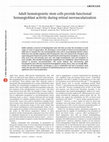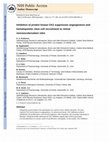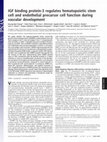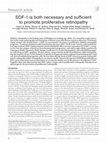Papers by Sergio Caballero

PURPOSE. Age-related macular degeneration (ARMD) is the primary cause of blindness in people aged... more PURPOSE. Age-related macular degeneration (ARMD) is the primary cause of blindness in people aged of 50 years or more. The wet form leads to severe loss of central vision. Recent evidence supports that adult hematopoietic stem cells (HSCs) contribute to preretinal neovascularization. In the current study, it was determined whether HSCs, by producing both blood and blood vessels, provide functional hemangioblast activity during choroidal neovascularization (CNV) in mice. METHODS. Gfp chimeric mice were developed by bone marrow ablation of C57BL/6J mice and reconstitution with donor tissue from gfp ϩ/ϩ transgenic mice. Gfp chimeric mice underwent laser rupture of Bruch's membrane and were killed and eyes enucleated at 1, 2, 3, and 4 weeks after laser injury. CNV was examined by confocal microscopy of retinal flatmounts. Because endothelial progenitor cells (EPCs) derive from HSCs, immunocytochemistry was used to quantify relative the EPC contribution to CNV. RESULTS. Laser injury alone was sufficient to induce stem cell recruitment and subsequent CNV. Gfp ϩ cells formed part of the functional vasculature in the choroid as early as 1 week after injury and were present for the duration of the study. The relative EPC contribution to CNV remained fairly constant throughout the study and constituted almost 50% of the total vasculature. CONCLUSIONS. Adult stem cells are recruited to the choroid in a model of CNV, where they contribute to forming aberrant new vessels. This observation suggests that targeting stem cell recruitment to the eye may offer a novel therapeutic strategy for ARMD. (Invest Ophthalmol Vis Sci. 2003;44:4908 -4913)
Regulatory Peptides, 1999

Nature Medicine, 2002
Adults maintain a reservoir of hematopoietic stem cells that can enter the circulation to reach o... more Adults maintain a reservoir of hematopoietic stem cells that can enter the circulation to reach organs in need of regeneration. We developed a novel model of retinal neovascularization in adult mice to examine the role of hematopoietic stem cells in revascularizing ischemic retinas. Adult mice were durably engrafted with hematopoietic stem cells isolated from transgenic mice expressing green fluorescent protein. We performed serial long-term transplants, to ensure activity arose from self-renewing stem cells, and single hematopoietic stem-cell transplants to show clonality. After durable hematopoietic engraftment was established, retinal ischemia was induced to promote neovascularization. Our results indicate that self-renewing adult hematopoietic stem cells have functional hemangioblast activity, that is, they can clonally differentiate into all hematopoietic cell lineages as well as endothelial cells that revascularize adult retina. We also show that recruitment of endothelial precursors to sites of ischemic injury has a significant role in neovascularization.

Diabetes, 2007
We previously demonstrated that EPCs isolated from diabetic patients have a profound inability to... more We previously demonstrated that EPCs isolated from diabetic patients have a profound inability to migrate in vitro. We asked whether EPCs from normal individuals are better able to repopulate degenerate (acellular) retinal capillaries in chronic (diabetes) and acute (ischemia/reperfusion [I/R] injury and neonatal oxygen-induced retinopathy [OIR]) animal models of ocular vascular damage. Streptozotocin-induced diabetic mice, spontaneously diabetic BBZDR/Wor rats, adult mice with I/R injury, or neonatal mice with OIR were injected within the vitreous or the systemic circulation with fluorescently labeled CD34 ؉ cells from either diabetic patients or ageand sex-matched healthy control subjects. At specific times after administering the cells, the degree of vascular repair of the acellular capillaries was evaluated immunohistologically and quantitated. In all four models, healthy human (hu)CD34 ؉ cells attached and assimilated into vasculature, whereas cells from diabetic donors uniformly were unable to integrate into damaged vasculature. These studies demonstrate that healthy huCD34 ؉ cells can effectively repair injured retina and that there is defective repair of vasculature in patients with diabetes. Defective EPCs may be amenable to pharmacological manipulation and restoration of the cells' natural robust reparative function. Diabetes 56:960 -967, 2007

PURPOSE. Growth hormone (GH), insulin-like growth factor (IGF), and somatostatin (SST) modulate e... more PURPOSE. Growth hormone (GH), insulin-like growth factor (IGF), and somatostatin (SST) modulate each other's actions. SST analogues have been successfully used to treat proliferative diabetic retinopathy (PDR) that is unresponsive to laser therapy and to retard the progression of severe nonproliferative retinopathy to PDR. In this study, the endogenous expression of IGF-binding protein (IGFBP)-3 was examined in human retinal endothelial cells (HRECs), the direct effects of IGFBP-3 on HRECs were evaluated, and the possible involvement of IGFBP-3 in mediating the growth inhibitory effects of SST receptor (SSTR) agonists in HRECs was assessed. METHODS. The cellular localization of IGFBP-3 was examined with anti-IGFBP-3 and fluorescein-conjugated goat anti-rabbit IgG. HRECs were exposed to varying concentrations of human recombinant IGFBP-3, and growth inhibition was evaluated by thiazolyl blue (MTT) conversion. Apoptosis was examined using fluorochrome-annexin V staining. Conditioned media (CM) from SSTR2 agonist (L779976)-treated or SSTR3 agonist (L796778)-treated HRECs were analyzed by ELISA for changes in expression of IGFBP-3. RESULTS. HREC immunostaining showed cell surface and cytoplasmic IGFBP-3. Exogenous IGFBP-3 induced a dose-dependent inhibition of HREC proliferation and staining with fluorochrome-annexin V showed numerous apoptotic HRECs. HRECs exposed to the SSTR2 or SSTR3 agonists expressed IGFBP-3 in a concentration-dependent manner. CONCLUSIONS. Cultured HRECs expressed endogenous IGFBP-3. Exogenous administration of IGFBP-3-induced growth inhibition and apoptosis, supporting a regulatory role for IGFBP-3 in endothelial cells. SSTR agonists mediate their growth-inhibitory effect, in part, by increasing expression of IGFBP-3. (Invest Ophthalmol Vis Sci. 2003;44:365-369)
Diabetes, 1998
... Capillary Cell Proliferation and Migration Maria B. Grant, Sergio Caballero, David M. Bush, a... more ... Capillary Cell Proliferation and Migration Maria B. Grant, Sergio Caballero, David M. Bush, and Polyxenie E. Spoerri ... Their effects on migration were assessed using modified Boyden chambers. Seven Fn-f were tested on vascular cell migration and/or prolifer-ation. ...

Molecular and Cellular Biochemistry, 2008
Ubiquitous protein kinase CK2 participates in a variety of key cellular functions. We have explor... more Ubiquitous protein kinase CK2 participates in a variety of key cellular functions. We have explored CK2 involvement in angiogenesis. As shown previously, CK2 inhibition reduced endothelial cell proliferation, survival and migration, tube formation, and secondary sprouting on Matrigel. Intraperitoneally administered CK2 inhibitors significantly reduced preretinal neovascularization in a mouse model of proliferative retinopathy. In this model, CK2 inhibitors had an additive effect with somatostatin analog, octreotide, resulting in marked dose reduction for the drug to achieve the same effect. CK2 inhibitors may thus emerge as potent future drugs aimed at inhibiting pathological angiogenesis. Immunostaining of the retina revealed predominant CK2 expression in astrocytes. In human diabetic retinas, mRNA levels of all CK2 subunits decreased, consistent with increased apoptosis. Importantly, a specific CK2 inhibitor prevented recruitment of bone marrow-derived hematopoietic stem cells to areas of retinal neovascularization. This may provide a novel mechanism of action of CK2 inhibitors on newly forming vessels.

To determine the intravitreal levels of vascular endothelial growth factor (VEGF) in eyes with an... more To determine the intravitreal levels of vascular endothelial growth factor (VEGF) in eyes with anterior hyaloidal fibrovascular proliferation (AHFVP). Methods: Three eyes of three patients who underwent vitrectomy for proliferative diabetic retinopathy (PDR) and subsequently developed an AHFVP (AHFVP group) were studied. We measured the level of VEGF in vitreous samples collected at the primary and following operations by enzyme-linked immunosorbent assay. The vitreous levels of VEGF in 25 eyes of 22 patients with PDR were also studied as controls (PDR group). Results: The averaged VEGF level in the samples collected at the primary surgery was 1.98 ± 2.23 ng/mL in the PDR group, and it was 9.07, 1.94, and 8.07 ng/mL in the AHFVP cases. After the primary surgery, the VEGF level rose up to 49.50, 15.60, and 50.60 ng/mL at the subsequent surgeries for respective cases of the AHFVP group. These levels of VEGF were more than five times higher than the baseline at the primary surgery. Conclusion: The subsequent increase of the VEGF level after the primary surgery in eyes with an AHFVP suggests that the vitreous levels of VEGF are associated with the development of the AHFVP although only three eyes were studied.

PURPOSE. The primary cause of vision loss in people more than 50 years of age in developed nation... more PURPOSE. The primary cause of vision loss in people more than 50 years of age in developed nations is age-related macular degeneration (ARMD). The wet form of ARMD is characterized by choroidal neovascularization (CNV). A prior study has shown that adult hematopoietic stem cells (HSCs) contribute to approximately 50% of newly formed vasculature in CNV. Stromal-derived factor (SDF)-1 is involved with homing of HSCs from bone marrow to target tissue. Vascular endothelial cadherin (VE-cadherin, or CD144) is involved in endothelial cell adhesion. Preventing homing and/or adhesion of progenitor cells to damaged choroid could reduce CNV. METHODS. Adult C57BL/6J mice were lethally irradiated, and then received a transplant of purified c-kit ϩ Sca-1 ϩ HSCs from the bone marrow of green fluorescent protein (gfp) homozygous donor mice. Bruch's membrane rupture by laser photocoagulation was used to induce CNV. Animals were injected subretinally with anti-SDF-1, anti-CD144, or control, before or after laser photocoagulation. The eyes were enucleated, and the neural retinas were separated from the RPE/choroid/sclera complex. All tissues were flatmounted and qualitatively and quantitatively assessed by fluorescence microscopy. RESULTS. CNV lesions from eyes treated with anti-CD144 showed significantly less incorporation of gfp ϩ cells compared with those treated with anti-SDF-1. Antibody treatment generally reduced the degree of gfp ϩ stem cell recruitment and incorporation into the CNV lesions, compared with the control. Treatment with either antibody also significantly reduced the size of the CNV lesions. CONCLUSIONS. These results indicate that homing and adhesion of progenitor cells to CNV may be targeted differentially or in combination to prevent CNV. (Invest Ophthalmol Vis Sci.

American Journal of Pathology, 2006
We asked whether HSCs participated in the wounding response by forming astrocytes, retinal pigmen... more We asked whether HSCs participated in the wounding response by forming astrocytes, retinal pigment epithelia (RPE), macrophages, and pericytes. Lethally irradiated C57BL6/J mice were reconstituted with HSCs from mice homozygous for green fluorescent protein (GFP) and then subjected to laser-induced rupture of Bruch's membrane. After immunohistochemical examination of ocular tissue, GFP ؉ astrocytes were observed concentrated along the edge of the laser wound, where they and mural cells closely ensheathed the neovasculature. GFP ؉ vascular endothelial cells and macrophages/microglia were also evident. Large irregularly shaped GFP ؉ RPE cells constituted ϳ93% of RPE cells adjacent to the edge of the denuded RPE area. In regions farther away from the wound, GFP ؉ RPE cells were integrated among the GFP ؊ host RPE. Thus, postnatal HSCs can differentiate into cells expressing markers specific to astrocytes, macrophages/microglia, mural cells, or RPE. These studies suggest that HSCs could serve as a therapeutic source for long-term regeneration of injured retina and choroid in diseases such as age-related macular degeneration and retinitis pigmentosa. (Am J Pathol

Proceedings of The National Academy of Sciences, 2007
We asked whether the hypoxia-regulated factor, insulin-like growth factor binding protein-3 (IGFB... more We asked whether the hypoxia-regulated factor, insulin-like growth factor binding protein-3 (IGFBP3), could modulate stem cell factor receptor (c-kit ؉ ), stem cell antigen-1 (sca-1 ؉ ), hematopoietic stem cell (HSC), or CD34 ؉ endothelial precursor cell (EPC) function. Exposure of CD34 ؉ EPCs to IGFBP3 resulted in rapid differentiation into endothelial cells and dose-dependent increases in cell migration and capillary tube formation. IGFBP3-expressing plasmid was injected into the vitreous of neonatal mice undergoing the oxygeninduced retinopathy (OIR) model. In separate studies, GFP-expressing HSCs were transfected with IGFBP3 plasmid and injected into the vitreous of OIR mice. Administering either IGFBP3 plasmid alone or HSCs transfected with the plasmid resulted in a similar reduction in areas of vasoobliteration, protection of the developing vasculature from hyperoxia-induced regression, and reduction in preretinal neovascularization compared to control plasmid or HSCs transfected with control plasmid. In conclusion, IGFBP3 mediates EPC migration, differentiation, and capillary formation in vitro. Targeted expression of IGFBP3 protects the vasculature from damage and promotes proper vascular repair after hyperoxic insult in the OIR model. IGFBP3 expression may represent a physiological adaptation to ischemia and potentially a therapeutic target for treatment of ischemic conditions.

Journal of Clinical Investigation, 2005
Diabetic retinopathy is the leading cause of blindness in working-age adults. It is caused by oxy... more Diabetic retinopathy is the leading cause of blindness in working-age adults. It is caused by oxygen starvation in the retina inducing aberrant formation of blood vessels that destroy retinal architecture. In humans, vitreal stromal cell-derived factor-1 (SDF-1) concentration increases as proliferative diabetic retinopathy progresses. Treatment of patients with triamcinolone decreases SDF-1 levels in the vitreous, with marked disease improvement. SDF-1 induces human retinal endothelial cells to increase expression of VCAM-1, a receptor for very late antigen-4 found on many hematopoietic progenitors, and reduce tight cellular junctions by reducing occludin expression. Both changes would serve to recruit hematopoietic and endothelial progenitor cells along an SDF-1 gradient. We have shown, using a murine model of proliferative adult retinopathy, that the majority of new vessels formed in response to oxygen starvation originate from hematopoietic stem cell-derived endothelial progenitor cells. We now show that the levels of SDF-1 found in patients with proliferative retinopathy induce retinopathy in our murine model. Intravitreal injection of blocking antibodies to SDF-1 prevented retinal neovascularization in our murine model, even in the presence of exogenous VEGF. Together, these data demonstrate that SDF-1 plays a major role in proliferative retinopathy and may be an ideal target for the prevention of proliferative retinopathy. Nonstandard abbreviations used: AAV, adeno-associated virus; DME, diabetic macular edema; EPC, endothelial progenitor cell; HREC, human retinal endothelial cell; NVI, neovascularization of the iris; PDR, proliferative diabetic retinopathy; rAAV, recombinant adeno-associated virus; rSDF-1, recombinant SDF-1; SDF-1, stromal cell-derived factor-1.
Regulatory Peptides, 1993
PURPOSE. Extracellular matrix degradation is associated with neovascularization in diabetic retin... more PURPOSE. Extracellular matrix degradation is associated with neovascularization in diabetic retinas. Fibronectin fragments (Fn-fs) are generated during vascular remodeling. The effects of cellular fibronectin (Fn) and selected Fn-fs on adhesion, proliferation, and signal transduction in human retinal endothelial cells (HRECs) were characterized.

The role of adenosine receptor (AdoR) antagonists in human retinal endothelial cell function in v... more The role of adenosine receptor (AdoR) antagonists in human retinal endothelial cell function in vitro has previously been determined. In this study, efficacy of AdoR antagonist administration in reducing retinal neovascularization was examined in a mouse pup model of oxygen-induced retinopathy. A previously described model of oxygen-induced retinal neovascularization in newborn mouse pups was used to examine the effect of various AdoR antagonists on neovascularization. The nonselective AdoR antagonist xanthine amine congener (XAC), the A(2A)-selective antagonist ZM241385, the A(2B)-selective antagonists 3-N-propylxanthine (enprofylline) and 3-isobutyl-8-pyrrolidinoxanthine (IPDX), and the A(1)-selective antagonist cyclopentyl-1,3-dipropylxanthine (CPX) were used. After the hyperoxia exposure the animals received daily intraperitoneal injections of pharmacologically relevant doses of AdoR antagonists for 5 days. Control animals received vehicle (0.1% dimethyl sulfoxide [DMSO]) alone. The animals were then killed and perfused with fluorescein-dextran. Wholemounts of retinas from one eye were prepared and examined, whereas the retinas of the contralateral eye were embedded, sectioned, and stained for counting neovascular nuclei extending beyond the internal limiting membrane into the vitreous. Angiography of wholemount retinas showed reduction of neovascular tufts in animals treated with selective A(2B) AdoR antagonists. Quantification of the extraretinal neovascular nuclei showed that only animals treated with XAC, enprofylline, or IPDX showed a significant reduction in retinal neovascularization. By contrast, neither CPX nor ZM241385 had an effect on neovascularization. The A(2B)-selective AdoR antagonists inhibited oxygen-induced retinal neovascularization in vivo and may provide a basis for developing pharmacologic therapies for the treatment of proliferative retinopathies.

Regulatory Peptides, 1996
The molecular and cellular processes that induce rapid atherosclerotic plaque progression in pati... more The molecular and cellular processes that induce rapid atherosclerotic plaque progression in patients with unstable angina and initiate Ž . restenosis following coronary interventional procedures are uncertain. We examined primary de novo and restenotic lesions retrieved at Ž . the time of directional coronary atherectomy for expression of insulin-like-growth factor-I IGF-I , IGF-I receptor, and five IGF binding Ž . Ž . proteins IGFBPs , IGFBP-1, IGFBP-2, IGFBP-3, IGFBP-4, and IGFBP-5 in smooth muscle cells SMCs using colloidal gold immunocytochemistry. IGF-I, its receptor and binding proteins were not detected in SMCs of normal coronary arteries. IGF-I localized Ž . primarily in synthetic smooth muscle cells sSMCs in both de novo and restenotic plaques. IGF-I receptor localized on sSMCs and their processes and colocalized with IGF-I. Although morphometric analysis of IGF-I and IGF-I receptor immunoreactivity in sSMCs of de Ž . novo and restenotic lesions showed comparable levels of IGF-I 3.2 " 1.0 and 2.9 " 0.9, respectively , IGF-I receptor was significantly Ž . higher in de novo lesions as compared to restenotic lesions 10.7 " 2.5 and 4.2 " 1.3, P -0.05, respectively . IGFBP-1, IGFBP-2, IGFBP-3, IGFBP-4 and IGFBP-5 localized in the cytoplasm of sSMCs and in the extracellular matrix. Quantitative reverse transcription Ž . polymerase chain reaction QRT-PCR performed on de novo atherectomy specimens identified mRNA for IGF-I, IGF-I receptor, IGFBP-1, IGFBP-2, IGFBP-4, IGFBP-5 levels and detected mRNA for IGFBP-3. The expression of IGF-I, IGF-I receptor, and IGFBPs in atherectomy plaques suggests that the development of coronary obstructive lesions may be a result of changes in the IGF system.
Previous studies have suggested that disturbances in plasminogen activator inhibitor (PAI)-1 may ... more Previous studies have suggested that disturbances in plasminogen activator inhibitor (PAI)-1 may be relevant to the development of diabetic microvascular complications. To determine whether overexpression of PAI-1 in cells of retinal microvasculature would result in a disease similar to that observed in diabetes, ocular tissue from transgenic mice that overexpress human PAI-1 were examined.

Uploads
Papers by Sergio Caballero